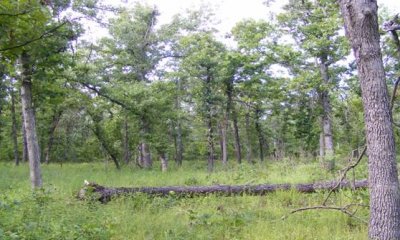
Fragipan Upland Flatwoods
Scenario model
Current ecosystem state
Select a state
Management practices/drivers
Select a transition or restoration pathway
- Transition T1A More details
- Transition T1B More details
- Transition T1C More details
- Restoration pathway R1B More details
- Transition T2A More details
- Transition T2B More details
- Restoration pathway R1A More details
- Transition T3A More details
- Transition T3C More details
- Transition T4A More details
-
No transition or restoration pathway between the selected states has been described
Target ecosystem state
Select a state
Description
These open woodland communities were strongly influenced by fire and seasonal wetness. Herbivory by native (now expatriated) ungulates also played a role. Consequently, drought and fire-tolerant post and blackjack oaks over a ground flora of tallgrass prairie grasses, sedges and wildflowers made up the flatwood community. There are two phases associated with this reference state.
Submodel
Description
Most current areas of Fragipan Upland Flatwoods have experienced fire exclusion for decades. In the absence of fire, ongoing recruitment of trees into the canopy develops a closed canopy, shading out the rich herbaceous ground flora. Black oak and mid-story species increase. Herbaceous cover and diversity greatly diminishes, leaf litter builds up, and more shade-tolerant woodland species persist, such as elm-leaved goldenrod, panic grass and spreading aster. The understory also develops with oak and hickory saplings along with sassafras.
Submodel
Description
Although many of the closed Fragipan Upland Flatwoods are now fenced, most have been heavily grazed by domestic livestock at some point in their history. Grazing decreases the cover and abundance of saplings, shrubs and herbaceous ground flora, opening up the understory. Weedy native shrubs and vines, such as coralberry, gooseberry, poison ivy and Virginia creeper, often flourish after grazing, and exotic species like tall fescue and sericea lespedeza increase in abundance. Poorly managed grazing can cause compaction and denudation of the soil surface, allowing mats of lichens and mosses to flourish. Soil compaction may also further limit height growth of trees. With poorly managed grazing, this can result in an increase in weedy natives such as broom sedge, and exotics such as sericea lespedeza if they are present. Single-tree timber harvesting also occurred, resulting in a high grading of the canopy structure, creating many stands with poor quality trees.
Submodel
Description
Conversion of flatwood ecological sites to planted, non-native grassland species such as tall fescue and red clover has been common occurrence. Clearing is often done by bulldozing. This practice often strips the thin topsoil along with most of the native ground cover plants. Occasionally, clumps of trees will be left in small groves for shade, giving the structural appearance of historic woodlands. However, Fragipan Upland Flatwoods have most often been converted into tall fescue grasslands, adjacent to densely overgrown and grazed woodlots. A return from this condition to a flatwoods state requires enormous cost and management inputs.
Submodel
Mechanism
Fire suppression; high grading timber harvest; uncontrolled domestic grazing
Mechanism
Thinning; prescribed fire - 1-3 years; forest stand improvement
Mechanism
This transition is the result of poorly managed domestic grazing and improper logging activities.
Mechanism
This transition is the result of clearcutting the hardwood canopy species and planting shortleaf pine.
Mechanism
Exclude domestic grazing; thinning; prescribed fire - 1-3 years; forest stand improvement; extended rotations
Mechanism
This transition results from the exclusion of domestic grazing and implementation of good forest management activities.
Model keys
Briefcase
Add ecological sites and Major Land Resource Areas to your briefcase by clicking on the briefcase (![]() ) icon wherever it occurs. Drag and drop items to reorder. Cookies are used to store briefcase items between browsing sessions. Because of this, the number of items that can be added to your briefcase is limited, and briefcase items added on one device and browser cannot be accessed from another device or browser. Users who do not wish to place cookies on their devices should not use the briefcase tool. Briefcase cookies serve no other purpose than described here and are deleted whenever browsing history is cleared.
) icon wherever it occurs. Drag and drop items to reorder. Cookies are used to store briefcase items between browsing sessions. Because of this, the number of items that can be added to your briefcase is limited, and briefcase items added on one device and browser cannot be accessed from another device or browser. Users who do not wish to place cookies on their devices should not use the briefcase tool. Briefcase cookies serve no other purpose than described here and are deleted whenever browsing history is cleared.
Ecological sites
Major Land Resource Areas
The Ecosystem Dynamics Interpretive Tool is an information system framework developed by the USDA-ARS Jornada Experimental Range, USDA Natural Resources Conservation Service, and New Mexico State University.
